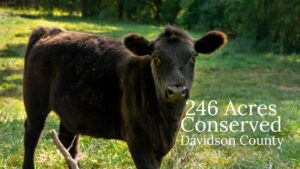
by Crystal Cockman
November 8, 2017

Last week, I visited The LandTrust for Central North Carolina’s Low Water Bridge Preserve with Aimee Tomcho, Conservation Biologist with Audubon North Carolina. The purpose of our visit was to look at the site’s suitability for a program called the Forest Landbird Legacy Program (FLLP).
The Forest Landbird Legacy Program (FLLP) guides and supports land management and habitat restoration to benefit forest birds. By establishing a protected and properly managed network of forested landscapes along the Atlantic Flyway, Audubon will work to increase and maintain healthy populations of forest dependent priority species. Audubon enlists landowners and foresters to help support birds that depend on forested landscapes along the Atlantic Flyway. This program provides outreach, financial assistance, tools and training that promote bird-friendly forestry practices and drive forest conservation.

In North Carolina, Audubon collaborates with conservation partners to lead the FLLP initiative establishing outreach and forest stewardship in four focal areas: Northwest Mountains, Central Piedmont and the Uwharries, the Northern Piedmont and the southeastern Coastal Plain. The Low Water Bridge Preserve falls in the Central Piedmont and Uwharries focus area.
We were looking at the property to see what ways we might be able to increase the habitat’s suitability for birds. The program focuses on land parcels with at least 50 acres of 50-year-old+ trees. The Low Water Bridge Preserve is now 1308-acres (thanks to a recent addition), and a lot of the tract is in mature hardwood forest.

We began by walking the northwestern block of land (north of Low Water Bridge Road and west of the Uwharrie River). This forest is mainly mature hardwood trees, and had a good mid-story and understory. There were lots of holly trees and sourwood trees in the mid-story, and lots of forbs in the understory. When thinking about how to diversify a forest for different bird species, they occupy different heights of the forest, so having a diversity of trees and shrubs found at various heights means you will have an increased diversity of bird species. Audubon is seeking to work with private landowners to maintain forest blocks in a way that mimics the characteristics of natural forest dynamics. Thankfully, for this block of land, the natural forest dynamics are already doing the job for us. Therefore, there isn’t really any management needed here to increase the quality bird habitat. The site can be recognized by FLLP as a model forest.

We also visited the southwestern block of woods, which had some younger trees near the road, but further in the forest we found some similarly aged older oaks with a lot of young saplings growing up amongst them. This area could benefit from some management that would enhance quality bird habitats. Some of these activities include creating small canopy gaps and cavity trees, among other practices, to support forest landbird diversity. The forest was largely comprised of just a few species of tree, so creating these openings would enhance the diversity found here by allowing sunlight to reach the forest floor and new species to emerge. Prescribed burning may also be a component of the management to favor the more desirable wildlife trees like oaks and hickories over sweet gum and maple. We also would like to enhance the rivercane habitat found along the river in this bottomland area. Rivercane is habitat for Swainson’s warbler, a priority species found in the Uwharries.

Other priority species that FLLP is working to protect habitat for include the American Woodcock, Whip-poor-will, Wood Thrush, Black-throated Green Warbler, Cerulean Warbler, Prothonotary Warbler, Kentucky Warbler, Brown-headed nuthatch, Prairie warbler, Worm-eating Warbler, Canada Warbler, and Golden-winged Warbler.
FLLP works with landowners to see their goals, values, and concerns addressed. They will contribute up to 75% of the cost of recommended actions, and these can be done by the landowner themselves. If you have land you may be interested in working to enhance the bird habitat on, you can contact Aimee Tomcho at atomcho@audubon.org or 828–419–0890.